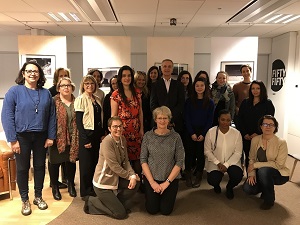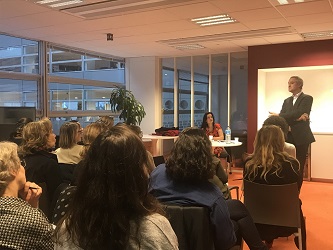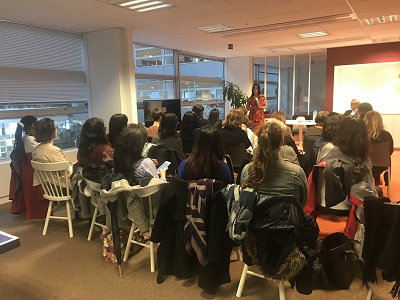WELLNESS… bien-être – what does it REALLY mean?

Wellness was the theme of our latest PWN/Professional Development Workshop, led by Ferroudja Meghenem on 28th March 2018 in the beautiful premises of TF1.
Article by Ferroudja Meghenem.This workshop had two main objectives: learn some keys to enable us to better know ourselves through the wellness path and be able to identify our individual areas of improvement in order to increase our well-being.
At the beginning, I shared a wisdom from the famous Chinese philosopher, Confucius, which resonates with me and was, according to me, a good way to introduce the topic of Wellness:
The plant which grows very easily will never flourish when exposed one day to sun and ten days to cold. To be able to grow, the plant needs to be exposed regularly to sun.
Before presenting the wellness concept, I first asked each participant their own definition of Wellness in one word spontaneously. I was not really surprised about the answers. The main words that emerged are the following: “balance”; “harmony”; “well-being”.
In France, the term of Wellness is applied in many ways. In particular, it has long be used by the SPA and thalassotherapy industry, and if we search for a brief definition on the internet, it is usually translated by “well-being” / “bien-être”.
So this workshop was a great opportunity for me to share, with people in France, another definition of Wellness, that used by the National Wellness Institute in the United States, that I personally use and that I support as part as my professional activity:
Wellness is, above all, an active process through which people become aware of, and make choices toward, a more successful existence.
The word “active” has its importance since it suggests the responsibility of each of us for our individual growth.
Then, I presented the six dimensions of Wellness developed in 1976 by Dr. Bill Hettler, co-founder of the National Wellness Institute (NWI):
Occupational: Our personal satisfaction through work and the ability to establish balance between work and leisure time.
Intellectual: Our desire to open ourselves to new experiences in order to continue growing.
Emotional: Our capacity to understand our feelings and manage behaviours related to our emotional states.
Social: Our behaviour towards each other, our contribution in our environment.
Spiritual Dimension: Our capacity to discover meaning and purpose in life.
Physical Dimension: Our capacity to take charge of our health by making conscious decisions to be healthy.
Based on this interpretation, we can state that our flourishing on earth or our sense of well-being is a combination of each of these dimensions with our own ratios. Even if we all have common needs, everyone is unique so ratios may not be the same from one human to another. It depends on multiple things, such as our identity, our personal interests, our culture etc.
Nobody on earth can achieve 100% on each dimension. The most important thing is be aware that we can improve some things in our life in order to better appreciate it.
Once the six dimensions of wellness have been presented and explained at the level of the individual, it was interesting to show how they also can be applied in the corporate environment. Indeed, as well as individual should be aware of their own areas of improvement, companies also should make the move in the interest of both themselves and their employees.
The second part of the workshop consisted in presenting successful corporate case studies which have integrated wellness as part of their organization.
To address more deeply the corporate environment, we’d invited Charles-Henri Besseyre Des Horts, Professor Emeritus of HEC paris and Consultant.
Thus, it was a great opportunity to ta ke note of the history and organisation of the company SAS Institute (US) presented by Charles-Henri Besseyre Des Horts. SAS Institute has been one of the first companies that has implemented a wellness approach in their organization. I then pursued the discussion by briefly presenting two other companies which also have invested in wellness: Brocade (US) which set up a wellness movement inside the company called WellFit (considering five areas) and Mauritius Telecom which launched a wellness program structured in three parts in March 2017.
ke note of the history and organisation of the company SAS Institute (US) presented by Charles-Henri Besseyre Des Horts. SAS Institute has been one of the first companies that has implemented a wellness approach in their organization. I then pursued the discussion by briefly presenting two other companies which also have invested in wellness: Brocade (US) which set up a wellness movement inside the company called WellFit (considering five areas) and Mauritius Telecom which launched a wellness program structured in three parts in March 2017.
The last part of the workshop was intended to engage participants in an enjoyable experience: participants were first asked to complete a questionnaire in order to assess their whole-person wellness, then they discussed their results in small groups and, finally, one person from each group presented their feedback on the exercise to the entire group.
The exchange was very rich in each group. I really appreciated the huge participation and enthusiasm of each participant.
Some participants were positively surprised by their results which encouraged them to pursue their wellness journey and everyone was able to identify their areas of improvement.
Wellness is a beautiful topic and we have a lot more to say about it at both the individual and corporate level!
I would lik e to thank the team of TF1 for their warm welcome, Charles-Henri Besseyre Des Horts, Professor Emeritus of HEC paris for his contribution to this workshop, Romaine Johnstone and Agnieszka Jaros, PWN Professionnal Development co-VPs, for their invitation and organization and the participants for their awesome commitment and their interest in this workshop.
e to thank the team of TF1 for their warm welcome, Charles-Henri Besseyre Des Horts, Professor Emeritus of HEC paris for his contribution to this workshop, Romaine Johnstone and Agnieszka Jaros, PWN Professionnal Development co-VPs, for their invitation and organization and the participants for their awesome commitment and their interest in this workshop.
Ferroudja Meghenem, CEO of WELLNESS VALUES and Member of the National Wellness Institute International Standing Committee
